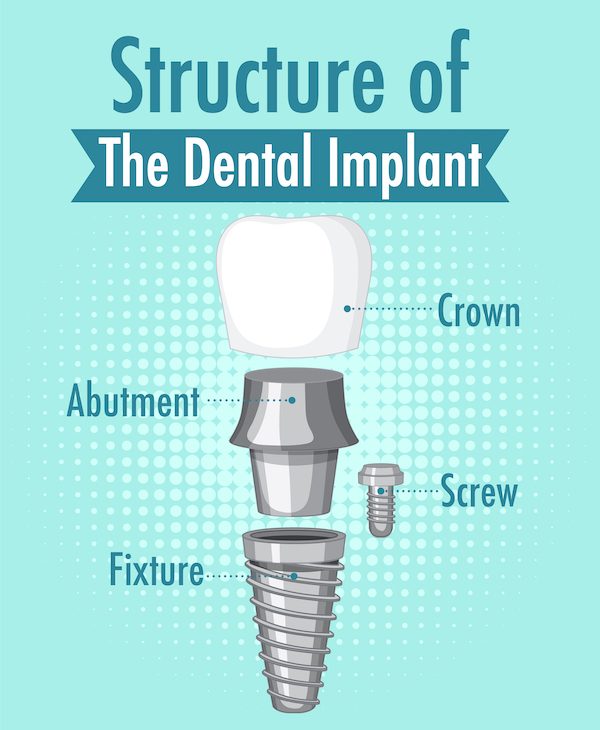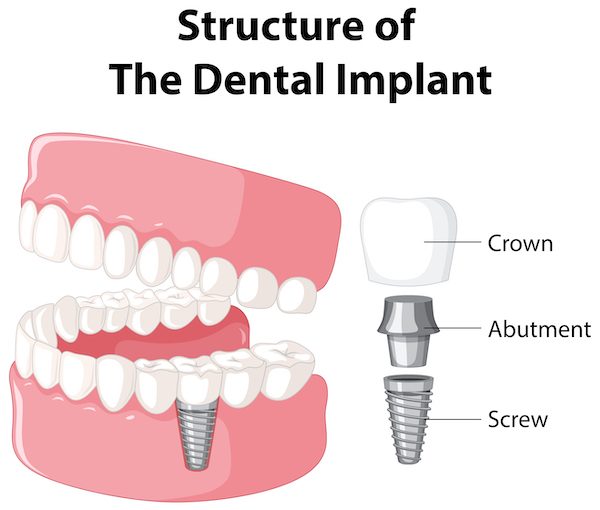What is a Dental Implant and What Does it Involve?

Dental implants are a life-changing solution for anyone who has lost a tooth or has a missing tooth.
In terms of appearance and function, dental implants are the best solution to fix a missing tooth or missing teeth.
There can be many reasons why you might have a missing tooth – injury, tooth decay, dental infection or gum disease.
Dental implants offer a permanent and natural-looking way to restore your smile and maintain dental health.
If you’re considering a dental implant, you might wonder what exactly the process involves and if it’s right for you.
In this blog, we’ll walk through the basics of dental implants, the procedures involved, and why they’re considered the gold standard in tooth replacement.
Understanding Dental Implants
Generally speaking, a dental implant has two parts to it:
1) The bottom part is a titanium screw which is placed into the jaw bone and
2) The top part is a dental crown which is attached to the titanium screw.

The dental implant is an artificial tooth root made from titanium that is surgically placed into the jawbone. Over time, this implant fuses and integrates with the bone through a process called osseointegration, creating a strong foundation for a replacement tooth or bridge.
The process of waiting for the implant to osseointegrate with the bone is much like waiting for the cement to set and harden so that the post in the cement can take on more weight and force.
Once integrated, the implant can be strong enough to support a dental crown, bridge, or even a full set of dentures, making it a highly versatile solution for various tooth loss situations.
Dental implants have gained popularity because they closely mimic the strength, function and appearance of natural teeth. Unlike traditional dentures or dental bridges, which sit on the gums or rely on adjacent teeth for support, implants integrate with the bone, providing a stable, long-term option that prevents bone loss and preserves the natural structure of the face.
How many teeth you are missing will determine how many dental implants you may need and affect the design of the teeth attached to your dental implant/s.
A single missing tooth will require one dental implant and a crown attached to it. If it was 2 or more missing teeth, then you will usually need multiple dental implants to support the bridgework for the teeth.
When you have all the teeth missing, then you will need an implant overdenture or All on 4/All on 6/All on X dental implant system. You can talk to your dental surgeon about your needs and goals for the treatment to find out which dental implant solution is best suited for your situation.
Why Dental Implants?
Before exploring the procedure, it’s helpful to understand why dental implants are such a valuable investment in oral health.
Here are some key benefits:
- Natural Look and Feel: Dental implants mimic natural teeth in strength, appearance and function, allowing you to smile, eat, and speak with confidence.
- Preservation of Bone Structure: When you lose a tooth, the bone in that area starts to shrink and deteriorate due to lack of stimulation from chewing and biting. Implants stimulate the cells in the jawbone, helping to preserve bone thickness and density and preventing changes to the face.
- Longevity: With proper care and maintenance, dental implants can last a lifetime, making them one of the most cost-effective options in the long term.
- Improved Comfort and Functionality: Unlike removable dentures, implants are fixed, so there’s no risk of something feeling loose or uncomfortable, and you can chew and eat your favourite foods (hard and soft) without worry.
- Protection for Surrounding Teeth: Dental implants don’t rely on adjacent teeth for support like dental bridges do, so dental implants have a strong benefit of preserving the health of your remaining natural teeth.
- Quality of Life and Overall Health and Nutrition: Dental implants are the gold standard when it comes to strength and function for chewing and eating. This translates to being able to confidently go out with family and friends to eat foods that you enjoy. Being able to eat and chew a larger range of foods means that your diet isn’t limited and you can have better nutrition for a healthier body and quality of life.

The Dental Implant Procedure
The dental implant process generally involves several stages over a few months. Here’s a closer look at each step:
1. Initial Consultation and Assessment
The first step is a consultation with a dentist or oral surgeon who will evaluate your dental and overall health. During this consultation, the dentist may take photos, 3D X-rays (CBCTs or cone beam CT), 3D scans, and impressions to get a comprehensive view of your teeth and jaw structure. This initial assessment helps determine if you’re a suitable candidate for implants, as there needs to be enough healthy bone to support the implant.
For those who may have insufficient bone density (often due to prolonged tooth loss or gum disease), bone grafting or other preparatory procedures may be recommended. This could add time to the process but will enhance the success rate of the implant.
2. Tooth Extraction (If Necessary)
If the damaged tooth is still present, it will be extracted to make room for the implant. In some cases, the extraction and implant placement can happen in the same appointment (known as immediate implant placement), but in other cases it’s best to allow the site to heal for a few weeks. Every patient and jaw is different, so your dentist will be able to guide you in what is most appropriate.
3. Bone Grafting (If Required)
In some cases, especially if the tooth has been missing for an extended period or there is extensive infection, bone grafting may be necessary to add volume and strength to the jawbone. Bone grafts can be taken from your own body or used from a synthetic source. This additional bone material is then integrated into the jaw, creating a strong base for the implant. Healing from a bone graft can take 4-6 months, but this step is crucial for ensuring a stable implant that will last for years. Bone grafting is often required in the upper jaw where the molar teeth are located and the jaw bone is too shallow – these are called sinus lifts.
4. Implant Placement
Once the jawbone is ready, the dentist will surgically place the dental implant into the bone. The procedure is typically done under local anesthesia, and there can be sedation options available for those who feel anxious. Sedation options include IV sedation (twilight sleep), Nitrous Oxide (happy gas) and oral sedation. During the procedure, the gums may be opened to expose the bone, and a small hole is drilled for the implant. The dental implant is then inserted and secured into position.
A single implant placement procedure usually takes between 30 minutes to 60 minutes, and after it’s completed, there will be a healing period where osseointegration (the fusion of bone and implant) occurs. This healing period can take anywhere from 3 to 6 months, depending on individual healing factors. Treat this healing period to be like waiting for concrete to set and harden after it is poured out.
5. Abutment Placement
Depending on the case, once the implant has fully integrated with the bone, an abutment is attached to it. The abutment is a small connector piece that allows the dental crown to be attached to the dental implant. This minor procedure involves the dentist exposing the dental implant and attaching the abutment. Afterward, the gums are given a couple of weeks to heal around the abutment before the final crown placement.
6. Crown Placement
After the gums have healed, it’s time for the final step: placing the crown. Impressions or scans of the implant and teeth are taken to ensure the crown is a perfect fit, both functionally and aesthetically.
The crown is then attached to the abutment, completing the restoration. Depending on your situation and your mouth, your dentist will go through the options of different material choices with you. The result is a natural-looking tooth that blends seamlessly with the rest of your smile.

Post Implant Care and Maintenance
Just because dental implants aren’t real teeth doesn’t mean you don’t need to maintain and care for them. Dental implants have a high success rate, but proper care is essential to their longevity.
Here’s what to expect and how to care for your new implant:
- Healing Period: After each stage of the procedure, there’s a healing period during which you may experience swelling, tenderness, and minor discomfort. Your dentist may prescribe medication and provide guidelines to aid in a smooth recovery.
- Oral Hygiene: Good oral hygiene is crucial to prevent infections and maintain the health of the surrounding gums and bone. Brushing twice a day, flossing, and using an antibacterial mouthwash are recommended practices.
- Regular Dental Visits: Regular check-ups with your dentist will ensure your implant is healthy and functioning well. During these visits, your dentist will clean the area and monitor the implant’s condition to prevent potential issues.
- Diet Considerations: After the procedure, it’s best to stick to soft foods for a few days to avoid disturbing the healing site. Long-term, there are no dietary restrictions, though avoiding overly hard or sticky foods can help protect the crown.
Are Dental Implants Right for You?
Dental implants are suitable for most adults, though it is important to understand that certain factors will impact their success:
- Healthy Jawbone: Sufficient bone is necessary for a stable implant foundation. The bone needs to be wide enough and deep enough, otherwise the implant won’t be stable. Much like if you tried to drill a screw into a piece of wood that was too narrow or shallow, it won’t be stable. If you have significant bone loss, bone grafting may be required.
- Healthy Gums: Gum health is crucial since infections like periodontal disease can impact implant success because it creates an unstable foundation for the implant.
- Non-Smoker or Willing to Quit: Smoking can impair healing in the body, especially the jawbone, and reduce the success rate of implants.
- Commitment to Oral Care: Because implants require diligent care, they’re best for those who can commit to good oral hygiene and regular dental visits.
If you meet these criteria, dental implants are a strong choice. They’re particularly beneficial for individuals seeking a long-term solution that enhances chewing and eating, supports facial structure, and offers the closest look and feel to natural teeth.
What are the risks associated with dental implants?
Dental implants are definitely a great way to improve your quality of life, however like with any medical procedure there are risks involved:
- Bleeding and Swelling: This is a very common issue after any medical procedure but usually very easy to manage and control with medication and review appointments.
- Infection: Infection is one of the most common complications with dental implants. They can occur during the dental implant procedure or after the dental implant is placed if proper oral hygiene is not carefully maintained. This can result in peri-implantitis. This risk is usually managed well through a proper assessment and planning by your dentist prior to considering implants to determine if you are susceptible to gum disease, uncontrolled diabetes or other medical conditions which may increase the risk of infection.
- Implant Failure: While the long term success rate of dental implants is very high, there are circumstances where they can fail. Implant failure can happen for different reasons, including insufficient bone, poor quality materials in the crown or implant, or incorrect placement of the implant. Implant failure may not always be immediate and can sometimes take several weeks or months to notice.
- Allergic Reactions: While very rare, this can occur with an allergy with local anaesthetic or the actual dental implant itself due to the different metal alloys. If you have any concerns about sensitivity or allergic reactions, please inform your dentist during the consultation appointment.
- Nerve Damage: Nerve damage during dental implant procedures are very rare. Nerve damage can cause a tingling sensation, a burning pain or prolonged numbness and these may be temporary and in some small cases, permanent.
Choosing an experienced dental professional minimises these risks significantly. This includes having an up to date 3D dental x-ray (dental CBCT) because it will allow the dentist to check all the structures in the jaw bone and plan safely to minimise the risks of complications. Risks should always be discussed to ensure you understand what is involved.

Addressing Common Concerns about Dental Implants
#1. Is a dental implant procedure painful?
Dental implant surgery is typically performed under local anaesthesia, so you shouldn’t feel pain during the procedure.
After the dental implant procedure, it may be a bit sore for the first couple of days and can be managed with prescribed medication for pain relief and generally subsides within a few days.
#2. How Long Does the Process Take?
The dental implant process, including healing, will usually involve 2-4 appointments and can take anywhere from 2-3 months to a year, depending on factors like bone grafting needs, the rate of osseointegration, and healing speed of each individual.
It is important to understand that implants need to be integrated with the bone enough for it to be stable for the next step to be completed, much like waiting for a concrete slab to be set properly before you build a house on top of it.
#3. How long is an implant procedure?
The actual procedure to place a simple dental implant is about 30minutes to 60 minutes long. The subsequent appointments for abutment placement and crown placement are usually 30 minutes.
#4. What if I Have Multiple Missing Teeth?
Dental implants can be customized to replace single teeth, multiple teeth, or even entire arches with solutions like implant-supported dentures (implant overdentures) or all-on-four implants or all on X implants.
#5. Is everyone suitable for dental implants?
Not everyone may be suitable for dental implants for a range of reasons.
Some patients may have healthy teeth that should be kept and saved rather than pulled out and replaced with a dental implant.
Some patients may have too much bone loss, others may have medical conditions that make it too hard (uncontrolled gum disease (periodontal disease), uncontrolled diabetes and heavy smoking) and the condition will have to be managed before dental implants can be considered.
Conclusion
Dental implants are a highly effective, natural-looking solution for missing teeth that can dramatically improve the appearance of your smile.
Dental implants can also significantly make eating a lot more comfortable and functional.
That is why they are a superior option to dental bridges and dentures. Dental implants have a high long term success rate making them a reliable, long-term option for many adults.
Although the process can be lengthy, the benefits make dental implants well worth the investment for those seeking a lasting and functional tooth replacement.
If you’re considering dental implants, please contact My Local Dentists to have a consultation and experience the peace of mind that comes with knowing your smile is in good hands.
Our qualified dental professionals can provide you with the insights and information you need to make an informed decision about dental implants.
